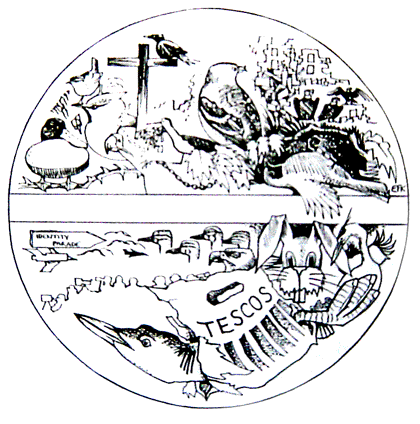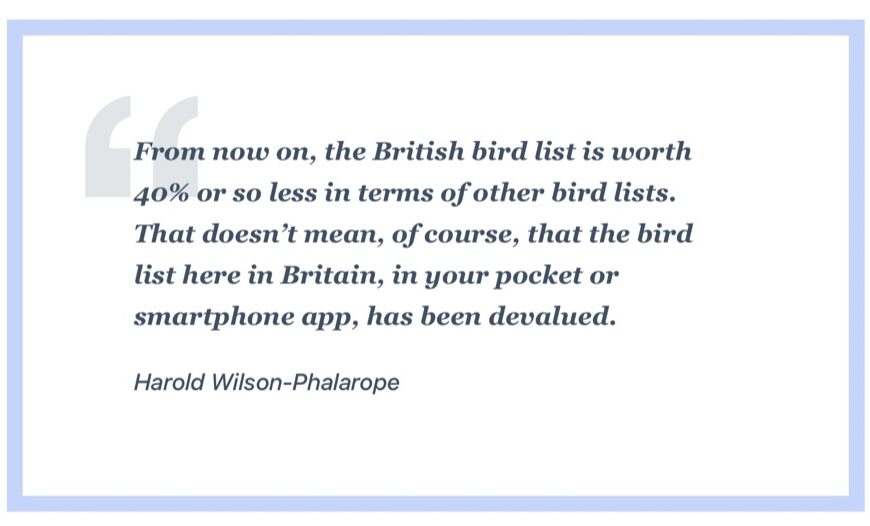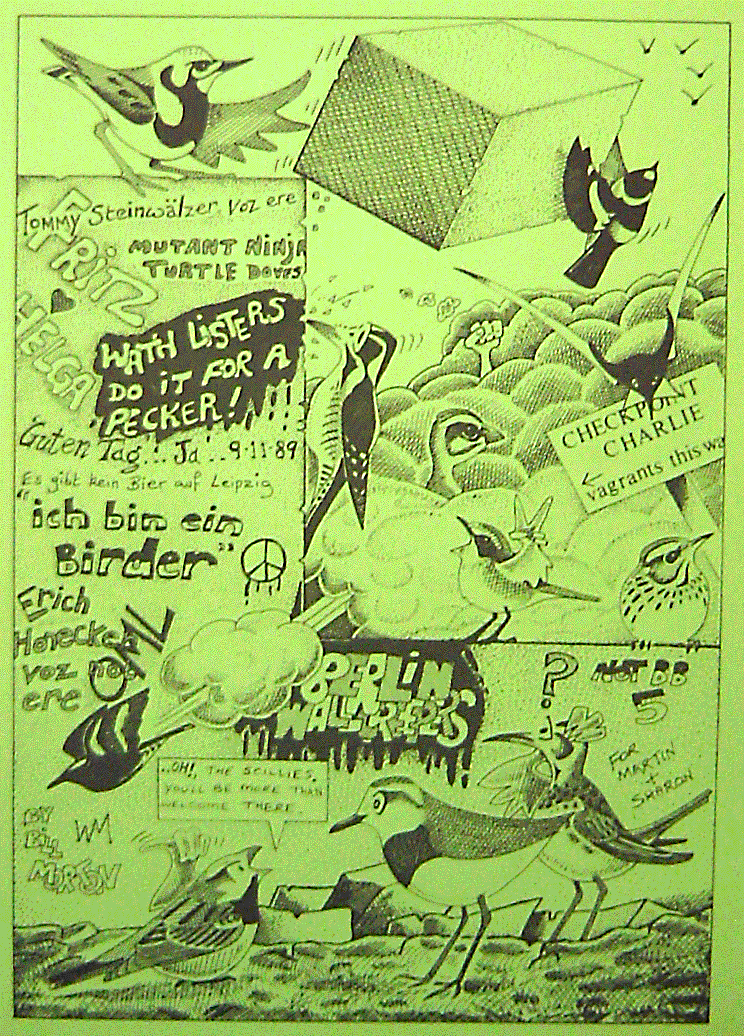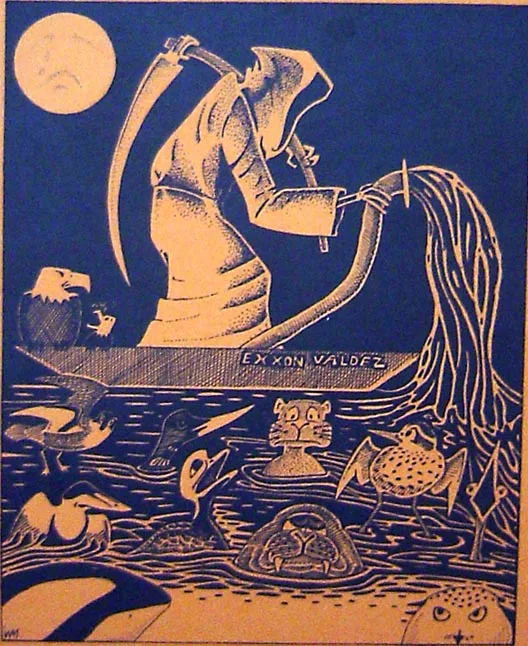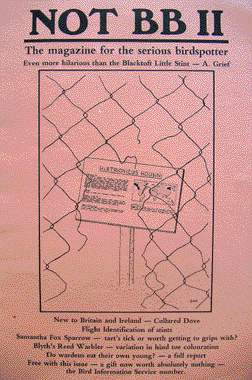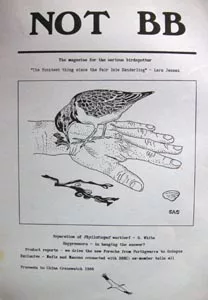The magazine for the serious birdspotter, Vol III
The magazine for the serious birdspotter
Even more outrageous than the Landguard Paddyfield Warbler
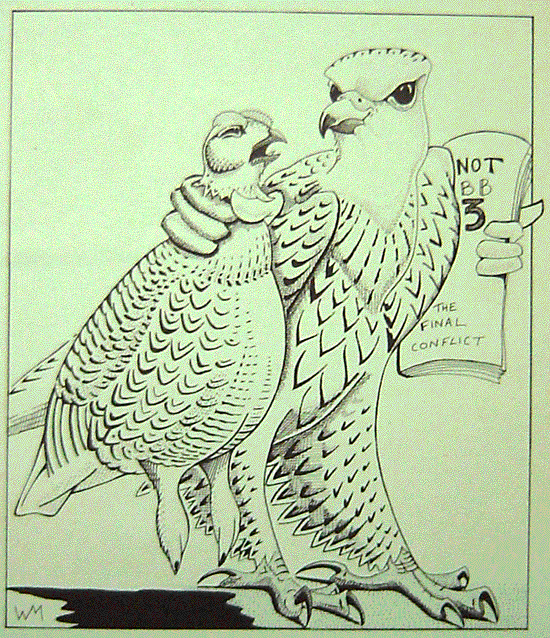
Why a Dusky Warbler in the hand is worth two in the Sueda bush by Eddie the Illeagle
Stop the massacre! Prevent splitting of species.
Lies, damn lies, and South Polar Skuas
Are you a yuppie birder? Ten tall-tale signs.
New Reserve – RSPB buys Scotland.
EXCLUSIVE! – Excerpts from Flycatcher: the book they tried to ban.
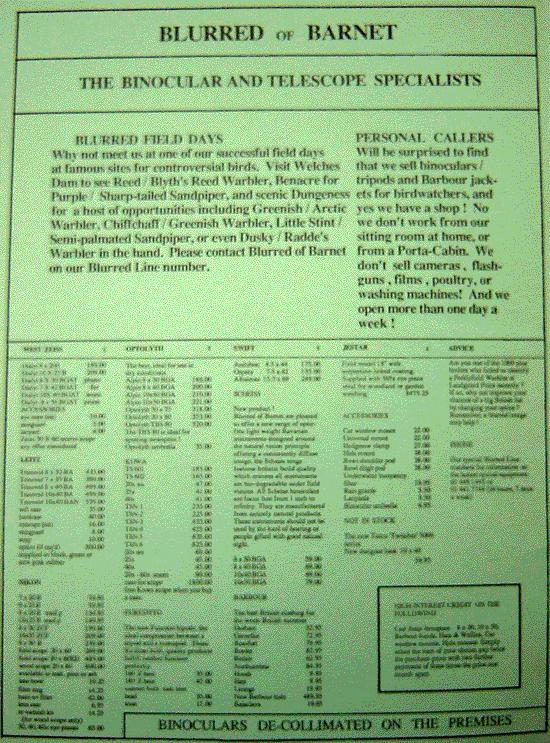

Editorial
Mr Y versus Not BB Enterprises
Last week saw the culmination of the bitterest legal battle to come before the Englsih courts since the Jeffrey Arche trial. For five months, the packed number 2 court at Wimbledon listened with growing incredulity as the evidence against Not BB mounted.
Mr Y, who declined to reveal his identity, sat impassively throughout the trial, wearing dark glasses, a toupee and a brown paper bag. He sought substantial damages for libel, and it was alleged by counsel on his behalf that, followin gthe publication of two issues of Not BB, Mr Y’s life had been made unbearable and his reputation had been completely destroyed. This was alleged to have followed as a natural and readily foreseeable consequence of the omission of Mr Y’s name from both issues.
It was contended on behalf of Mr Y that the defendants had been motivated by undiluted malice in perpetrating the complained of omissions. Giving evidence in open courty, Mr Y sobbed, “My life has been made unbearable and my reputation has been completely destroyed.”
Summing up, Lord Justice Guff-bias directed the jury to return a verdict of extremely guilty with knobs on. Legal observers anticipate the awarding of record damages, potential even higher than a year’s subscription to BB.
The BTO Tetrad Survey
Stanley Gibbons
continued from p73
…multiply the number of colonial breeding species by a figure coding for the letter of the tetrad, and add this figure to the running totals Q or T as appropriate, remembering to retain the result for insertion into column C, providing your square is coastal, otherwise scale the number of songbird habitat types by the coefficient Z if not greater than the number of hours spent in the tetrad and subtract from this the number of bird-hours per species of all the riparian non-passerines (shaded) seen to make specific use of habitats P to V, excepting of course gulls and the Dunnock P. modularis, which should be included in the preliminary tables already mentioned…
Monthly Round-Up
Twitching Planet Recent Reports
Last month produced a veritable Heard of rarities:
..where 3 Red–backed Shrikes were also seen. On the 10th a Rough – legged Buzzard gave brief views soaring over Knickers Down (Hants) and a Ring — necked Duck (see photo of Black Stork on p. 75) stayed at Passing Water until the 13th. Most notably, a White — winged Black Tern stayed briefly at Showing Well (Sussex) on the 15th – the fiftieth for the county. The 16th produced an emaciated White – billed Diver brought ashore at Bobby Sands (County Armagh). A claim of a Cock—-up—-of—–the———–rock gave unprecedented problems to the Listing Globe word processor.
By Not BB – the magazine that doesn’t have trouble with hyphenrh49&%$
Advertisements
And for the landlubbers who wish they were all at sea, we present two new products: Bemptair and Fulmis.
Bemptair will make you the talk of the neighbourhood. Rather than have your home smell like a poncy Norwegian pine wood or Bavarian peat bog, with Bemptair you get the authentic aroma of a large seabird colony. Deluxe modules are fitted with a rotating fan, to reproduce exactly the effects of changing wind direction.
Fulmie is designed to add a bit of fun to parties. Just invite the mostt elegantly dressed lady to pat Fulmie on the head, and your remarkably lifelike Fulmar-on-the-nest will cover her in a repulsive, foul-smelling liquid that remains for weeks. Guaranteed to bring a smile to even the most jaded of revellers or dourest of party poopers.
{mospagebreak title=DIM world of warblers, Cambs. Acro}
The DIM World of Warblers
by Dr Barnes Wallace
About the author: Barnes Wallace, legendary inventor of the bouncing Pom, coined the phrase “Dambastard Raid” to describe a successful twitch at Flannelborough
PALLAS’S WARBLER

This sprignly sprite from the Orient, a cohabitant of many a defoliating Sycamore the the more hardy Goldcrest, is probably one of our more ubiquitous autumn adventurers.Every flock of Kinglets in October doubtless contains a “sensational six-stripe” or its more squirrel-headed congener – the Inornate Warbler. Whilst on a clifftop perambulation, the fortuitous investigator may indeed stumble across a Two-barred or and Eastern Crowned Warbler, on extended vacation from their Balkalian birthplace, or even a Chiffchaff.
My grandmother and I first perceived a hovering “Siberian sunbird” amongst a mixed flock of Hume’s Yellow-broweds and Estonian Dunnocks at a Yorkshire headland in 1952. I can remember being astonished at the philatelic flavism of the lower back as this dazzling denizen of the Yakutensis river swamps displayed to an itinerant Pale-legged Leaf Warbler.
In the more enlightened days of old when my records used to get accepted (now that’s going back a bit, Eds) the bounding flight of this latter species was a familiar, specific pointer on spring seawatches, especially on days of heavy Prion passage.
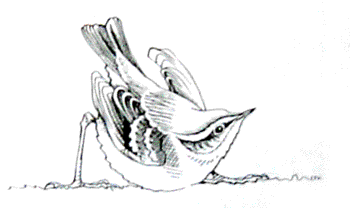
(Our doctor’s comment – “Now, now, Dr Witless, come this way, it’s for your own good…”)
Next month – Dr DIV Wassis writes on: “Acro-batics, the beak-dancing warblers of New Jersey and a load more old cock about Phalluss’s Warbler.”
Controversial Birds Identified – the “Cambridgeshire Acro”
Every now and then, a bird turns up that baffles even the most knowledgeable of bird spotters. In 1782 it was the Selborne Willow Warbler, in 1982 the Felixstowe Stint and in 1983 the Blakeney Tern. In 1987 it was of course the Ouse Washes Acrocephalus. From the beginning the identification was in doubt – Reed Warbler, Marsh Warbler, Blyth’s Reed Warbelr and Turnstone were all hot contenders. Unfortunately, much of the confusion was generated by relying on such trivial characters as tertial patterning, primary emargination and rump colouration.
To crack this tricky ID problem, the editors have generously drawn upon their vast experiences of Acrocephalus warblers (most have seen Reed Warbler and Chiffchaff, examined Mr Wheeler-Dealer’s snaps and consulted the Observer’s book of birds). Their summary of points clinching the identification is as follows:
The case for Blyth’s Reed Warbler –
There is a gaping hole in our lists between Sedge and Marsh Warbler
The case against –
The bird was in Cambridgeshire!
The verdict –
It’s off your list, boys!
(Fancy dear old Birding Globe, or whatever they call it this month, spending so many pages on this one!! EDS.)
{mospagebreak title=For Sale, Movie Guide, Wood Thrush or Woodn’t Thrush, English Language changes}
For Sale
Colour prints of the Siberian Thrush, Shropshire, Nov. 1985
Sent £1.50 and an sae to –
D. Mann’s Taxidermy Service
8 Stuffing Street
Fooledham
Shropshire PAXO 123
Photos of the 1989 White’s Thrush will be available shortly.
Warning
Advice to kid listers from Old Bill: Never accept lifts from verbose old ladies in leather-gear driving battered jalopies.
Movie Guide
Forthcoming films of interest to birders –
Soon to be showing well at a cinema near you: Shag
(Shag, the Movie, that is; not to be confused with Shag Hard 1 or Shag Hard 2, Eds)
First for the Western Palaearctic and Cornwall: Wood Thrush on St Agnes, Scilly
By Comfy Sofa
I had just finished a large gin and tonic at the Birders’ Rest on St Mary’s, when my make-up artist burst into the room and told me that a rare bird had been spotted on St Agnes or something, and “Wouldn’t it make good footage?” Pausing only to pull on my rugged, “country style” chin extension and polo-neck North Ronaldsay sweater, I took a taxi to the quay and caught the Codpeace inter-island ferry. We crossed the channel with the storm in full spate, our ears filled with the wailing and shrieking of the dippers jumping off the quay (surely “the wind in the rigging”, EDS).
I first caught sight of the Song Thrush as it hopped into a sheltered glade and 30 birders hopped in front of me. This Woodcock certainly seems a sprightly bird – – it uses its camouflage to avoid predators. I was convinced that it was about to catch and smash snails just like the Mistle Thrushes in my garden. Then my cameraman said agitatedly, “The Wood Warbler’s over there, where all the birdwatchers have gone, you old fool, and your chin’s in front of the lens again.”
With no time to lose, I pulled my boxed set of Birds of Leafy Lanes from my picnic hamper and was delighted to find that this bird could only be a young Night Heron and hence a first for Britain. I’m certainly glad I didn’t have to identify it, as I couldn’t have told it from a first-winter Wood Thrush with emarginated fifth and sixth remiges.
Due to one of the descriptions received of the claimed Wood Thrush on St Agnes, this record has now been rejected – Eds
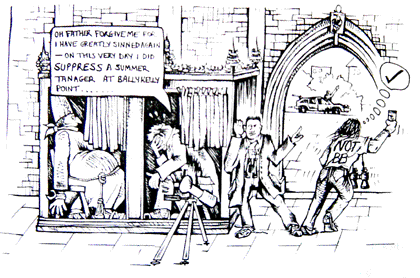
Changes to the English Language
In an attempt to sink Birding Globe by literally scattering hyphens throughout the ornithological nomenclature… whoops! What we meant to say was … We have decided to replace perfectly adequate English bird names with their American equivalents (shouldn’t that read “equivalents from all over the place, and especially Ben E King”? Eds), thus keeping ourselves occupied and maintaining our sense of self-importance into the bargain. A few examples are given below:
Black Vulture TO BECOME Afro-Caribbean Vulture
Garden Warbler TO BECOME Stately Home Warbler
Great Bladk-backed Gull TO BECOME Greater Black-backed Sea-gull
Following the recommendations of Who’s Voous in 1977
House Sparrow TO BECOME Slum Weaver
Mandarin Duck TO BECOME European Feral Duck
Robin TO BECOME Northern Red-breasted Bush-Robin
Further distinguishing it from the closely related and strictly sedentary Bank Robin of the Costa del Sol
Wren TO BECOME Jenny Wren
The following names are so manifestly apt that they are TO REMAIN:
Barnacle Goose, Black-headed Gull, Dartford Warbler, Kentish Plover, Iceland Gull, Marsh Tit, Ring-necked Duck, Slavonian Grebe, Social and Liberal Democratic Party, Turtle Dove, Scaly Thrush…
We hope that everyone who feels we have come to a bad decision on any particular name will write to us by, at the latest, 31 March 1988.
A.G. Bedsox, P.R. Codger, I.J. False-teeth, P.J. Grout, Rock Hudson, T.P. Infirm, J.T.R. Sanatogen, K.E.L. Zimmer-frame and lots of other sprightly young chaps.
BOU-BOU Records Committee, c/o Drawers 13-20, British Museum (Nat Hist), Sub-Department of Gerontology, Tring, Herts.
When this document is being ridiculed in public, it should be referred to as:
Changes Of Bird-names By Lethargic, Egotistical Records Sub-committee (C.O.B.B.L.E.R.S.)
{mospagebreak title=House Sparrow, Roger Rook Investigates, Happy Birthday RSVP!}
The occurrence of the House Sparrow in Britain and Ireland
Reference to county bird reports reveals that the House Sparrow Passer domestos is very rarely recorded in the British Isles. Records are so sparse that it was decided to investigate the true status of the species, with a questionnaire sent out to top twitchers. Most respondents remarked that they had few problems getting the bird onto their year-lists in January, but not a single observer could remember seeing a House Sparrow later in the year. Most of the records for 2 January came from Scotland, where correspondents could not recall ever seeing House Sparrow on New Year’s Day – indeed, most couldn’t remember anything at all about New Year’s Day.
This striking, mid-winter occurrence, as shown in Fig. 1, is most unusual for a vagrant, although a similar pattern is exhibited by the Killdeer Huntedby robertdeniroensis and the Bustards Illegitimidae. In view of the evidence of this survey, recent claims of House Sparrows breeding in Britain cannot be upheld – presumably, confusion with Tree Sparrows Passer mononous is responsible.
House Sparrows are probably more regular as vagrants than is currently realised, as they are dowdy and easily overlooked. Careful checking of flocks of Captain Scarlet Rosefinches Spectrum indestructiblensis in the Northern Isles and parties of North American sparrows Assistedpassidae around docks and harbours may prove fruitful; while another possible identification pitfall that should be borne in mind is the Dunnock Prunella almostasboringasarealsparrowensis.
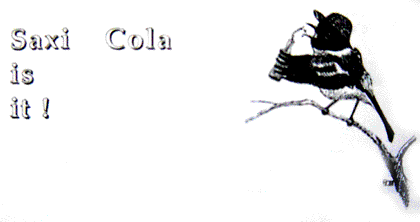
Roger Rook investigates
On this week’s radio programme, Roger Rook investigates a shady North Norfolk organisation which has left behind a trail of broken promises and broken hearts:
‘Operating out of a seaside phonebox, this organisation specialises in promising clients extremely rare birds. The unwitting customer may then travel the length of the country only to find the bird has flown. Victims of this “string” may be driven to the edge of breakdown.
‘This phone service is of the same type as those “saucy” phone messages which fill the pages of the tabloid press. But you won’t find this number in any newspaper. The proprietor of the organisation, a “Big” Moleington, is well known to birdwatchers and relies on word-of-mouth and publicity in a certain “adult” magazine to advertise the service.
‘A typical case is that of young Andy Rabid, aged just 20. He phoned “Bird Gone” one night and was confidently informed, “There is a Cashmere Pullover on St Agnes.” He then “borrowed” £62.20 out of his mother’s purse, chartered a boat and travelled 600 miles only to join hundreds of other ornithologists on a birdless, windswept heath. Andy Rabid is now a broken man; he dropped out of polytechnic and is reduced to putting rings on birds at a nuclear power station in Kent.
‘Fond of phrases such as “seen going to roost,” “performing well all day” and “is probably still in the area,” Big Adrian is a hard man to bring to account. he has started a series of apparently unrelated business ventures – BIN Birding, Bird Gone, Bitching, Cockatoo Tours – but on closer inspection familiar names keep cropping up on the list of directors, In particular, there’s Adrian himself, a mysterious R.U. Robbingus, a character by the name of O’Really-Evans, and a man known only as “Nicker”.
‘We caught up with Moleington at a cement quarry in the south of England. the resulting conversation was recorded on tape:’
R Rook: ‘How do you answer the complaints of the thousands of innocent dippers throughout the country who paid money in good faith, and who have been led on a wild goose chase by your authoritative tones?’
A Moleington: “I only give phone interviews. Please leave your message after the tone.”
R R: ‘I don’t seem to be getting through here, Mr Milkingparlour. There are many disappointed people out here who would like some answers. Mrs Rabid of Leicester says she would like to strangle you with her own bins’ strap.’ (then whispering) ‘Err, excuse me Mr Moleington, would you have any objections to attacking me at this point? I’ve got thousands of listeners who only tune in to hear me get a beating.’
A M: ‘Who is this dude? We’ve got loadsa money and muscle, so beat it, or I’ll….’
R R: ‘What are you doing with that telescope, Mr Moleington? Mr Moleington!…’
Advertisement
For sale – one damaged Kowa telescope with customised rainguard. Contact “Big A” on the usual number, and leave your National Insurance details, blood group, distinguishing marks and message after the tone.
Happy Birthday RSVP!
Next year is the 100th birthday of the RSVP. In the years since its inception, the society has changed from a small band of amateurs seeking to foil egg collectors and falconers to a large band of amateurs seeking to foil egg collectors and falconers. With its mahy fine achievements to its name, it is difficult – if not impossible – to select the most outstanding ones. In this article, we present a personal list of the major events that have made the RSVP what it is today – the largest conservation organisation in Bedfordshire.
1. The purchase and preservation of such scenic areas as Dungeness and Elmley.
2. The introduction of thousands of people to the stark beauty of a dead Scots pine.
3. The construction at Titchwell of the most expensive toilet block in the world.
4. The winning of the popular Busman’s Holiday TV quiz show by a highly trained, crack team of wardens.
5. The conviction fo dozens of enthusiasts whose only crime was that they liked climbing trees and crags in the dark.
6. The appontment of a director, appropriately named Peter Condor. This sensible approach to staff selection has unfortunately not been continued. However, we should like to nominate Eddie the Eagle for the next available position.
What will the next one hundred years do for the RSVP? Of one thing we can be sure: the Society will have to do well to better its performance since 1989. The Not BB editorial team says, “Good on yer, and good luck!”
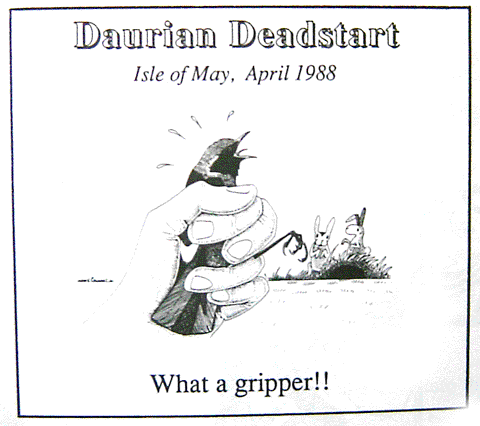
{mospagebreak title=East Merchant Bankers, Birdspeak}
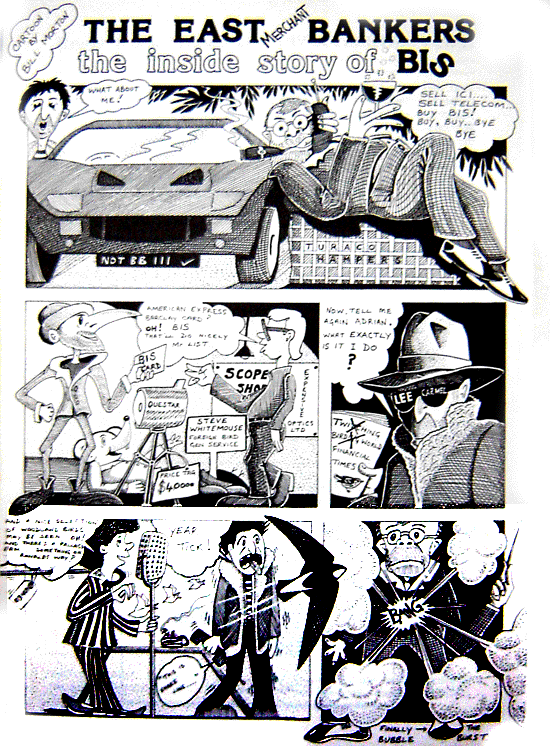
It pays to improve your birdspeak
Clumber Park – to hurriedly stop a vehicle so that it completely blocks the road.
Elmer’s End – the loss of circulation in the nether regions experienced by many twitchers in association with lack of sleep and lightness of wallet.
Ely Beet Factory – the appalling sort of music listened to by the only bloke you can find to drive overnight for a rarity.
Gilkicker – person who asks if you’ve seen anything, waits ’till you say you haven’t, then says, “One Yellow-browed, eh? Must have been at least twenty, and a couple of Pallas’s. You didn’t get the Sibe Thrush then … a nice male, saw it just before the White-tailed Eagle flew over…” (short life expectancy)
Hoy – the friendly greeting of a farmer findng you doing a bird census on his land.
Little Paxton – the obligatory 17-year-old, petrol-paying car-filler on every long distance twitch, who is always the one sent out to phone Birdline (using his own money).
Margate – the peculiar piece of ironwork in the field of view of every rare bird that is not really a gate, nor a fence, and completely defies description when you’re trying to give directions.
Minsmere – RSVP clothing department.
Ouse Mouth – the medical condition (ulcers etc) associated with eating nothing but Mars bars and crisps for a week.
Outer Hebs – birds on someone’s list that really shouldn’t be there.
Pendeen – the claustrophobic feeling encountered when on a major twitch.
Penzance – to write articles for Birding Globe.
Ronaldsay – to speak in persuasive tones to try to get yourself on the first boat for a rarity.
Scilly – mindless idiot cluttering up the streets of Hugh Town in October.
Slapton – Sloaney birder, usually male, wearing green wellies and a Barbour.
Slapton Ley – Slapton’s girlfriend.
Wexford Slobs – the fat gits who always block the view into the gardens off Barnaby Lane, St Agnes.
{mospagebreak title=Product Reports, TV Campaign}
Product Reports
1. The “Ace” PIckle Guard
It’s happened to us all. You’re sitting in a hide, eating your cheese and picalilli sandwiches, a bird drops in, you put up your bins, and get an eyeful of pickle. Unknown to you, a blob of picallili has squidged out of the sandwich, and dropped onto your rubber eyecups.
The “Ace” pickle guard is a neat device that clips onto your binocular strap, and can be slid over the eyecups at mealtimes. Made of plastic, it weighs only 200 grammes, and comes in an exciting black colour. Optional red spot model, £20 extra.
Available by mail order only, the “Ace” pickle guard works equally well on crisp crumbs, lumps of Mars bar, bird droppings and dribble.
2. Dippety Dip – an exciting new bird game from the Spurnuda Triangle
The rules are simple. A rare bird is found and quickly trapped. It is then taken into a small dark room whilst the player, having only had brief views, has to watch outside.
Suddenly, the door bursts open and several people run out, each carrying a small bag. Only one contains the “boy”. You have to quickly decide in which one it is, whilst they all vanish in different directions. Having chosen, you must follow and relocate the bird before your YNT subscription runs out. Follow the wrong bag, and it’s dippety dip for you sonny. However, if you pick the right one and find the bird in time you could win the star prize – a photo of a Tengmum’s-the-word Owl.
3. Tripods
In an attempt to get some free equipment, we decided to test three top of the range tripods.
A random selection of three RSVP wardens was lined up, and each one was whacked over the back of the head with the tripod. The results were as follows:
The Conman 400
Not bad. One warden claimed to have seen stars and all three reckoned to have seen a Collared Flycatcher.
The Black Eye
A poor result, mainly as it was so heavy we could hardly lift it let alone whack anyone.
The Smack 83
By far the best. Resulting instant hospitalisation and long-term brain damage for all three wardens, who subsequently failed to identify a new species of wader for the UK.
Famous TV Advertising Campaigns
Number 322: The Selling of Bird Spotting Magazine
The advert is set in a high-street newsagent. A customer enters the shop, to make a purchase:
Customer (highly nervous) – “Could I have, err… could I buy a copy…”
Voice-over – “No need to be embarrassed.”
Shop assistant – “Can I help you, sir?”
Customer (a little calmer) – “Could I have, err, a copy of err, a packet of condoms, please?”
Voice-over – “She probably sells them every day.”
Shop assistant – “Anything else?”
Customer (whispering, glancing around) – “Err, yes. And, umm, a copy of, you know, umm, Bird-Spotting Magazine.”
Shop assistant – “Certainly sir.”
Voice-over – “You see, nothing to be afraid of at all.”
Shop assistant (shouting) – “Mr Dawn, how much is Bird-Spotting?”
Customer – runs from shop in total embarrassment.

*** Stop Press *** Stop Press *** Stop Press *** Stop Press
Aids threat to promiscuous seabirds. Scientists hope to cross Blackcock with Sheathbill as part of a Safe Leks Campaign.
*** *** *** *** ***
{mospagebreak title=Best Recent Bird Photo, Advertisements}
Best recent bird photograph
As Britain forges yet closer links with the continent (thanks to the Chunnel etc), we thought it appropriate to combine our traditional photographic competition with the European Space Agency’s “Eurostat Spy-Print Awards”.
The winning entry, reproduced below, and recipient of the “Not BB Grain Merchant of the Year Award 1988”, was the usual joint effort from Cottage Industries. Taken using the latest ultra-high resolution, computer enhanced Free-Wheeler lenses carried on the Lose-B-Sat V, orbiting 280 km above the Kent countryside, you can almost tell it’s a plover.
[Life imitating art alert! – recently read of large mammals being identified on satellite photos.]
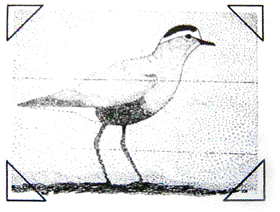
Advertisements
Christmas is Coming
Why not make a change this coming Yuletide? Buy your Xmas gamefare from the Wildfowl Thrust. We have plenty of fattened Ne-Nes, choice Lesser Whitefronts, tender Snow Geese and good reductions on hybrids, but we’re running a bit low on Falcated Ducks as usual.
“p-p-p-pick up a … Pufin” Covered with a rich, thick chocolate-brown coating, with a delicious chewy interior, these make a tasty seaside snack for all the family.
Birders wives, girlfriends, mistresses!
Are there times when the man in your life seems to have a one-track mind? Times he trembles every time the phone rings, babbles about cripplers, Yanks and Sibes? Times when he doesni’t seem interested in you no matter if you wear your best we tee shirt, erotic nightie or parade provocatively with that slinky naughty walk that used to set him on fire (give that man a cold shower, and bring that woman to me, EDS)?
If so, we’ve got the answer – Rod Martin. Just slip a couple of the easy-to-swallow capsules in his dinner, and all that twitchiness will disappear.
New from Starkraven:
Stenchcoat to keep the wind out (or, for vegetarians, to keep it in)
YOC poetry competition results
Winner:
Ode to a Steller’s by John Sears
My heart aches and a drowsy numbness pains
my sense as though of hemlock I had drunk
or emptied some dull opiate to the drains.
One minute past and lethe-wards had sunk,
’tis not throuhg envy of thy happy lot
but being too happy in thine own happiness
that though light-winged dryad of the seas,
in some melodious plot of beaches seen
and Eiders numberless,
doth avoid my Optolyth with the greatest of ease.
And now for the runner-up: an anonymous contribution from South London –
I luv Beddington
I luv sludge
I luv sewage-farms
‘cept when I fall in the mud.
Although several words were deleted, as they were considered unsuitable for this hallowed journal, the judges particularly liked the novel use of iambic pentameter in this one. Well done Gary!
Letters
Melanistic Pallid Swift in Kent On November 14th 1984, I saw an unusual Pallid Swift showing well at Warden Point on the Isle of Sheppey. The description was as follows:
Appearance: Basically as juvenile Swift but it was late autumn (and I missed the ones at Portland).
A. CINCLUS
Tedious whinger Sir, I used to think sarcasm was the lowest form of wit until I read Not BB.
Name and address supplied
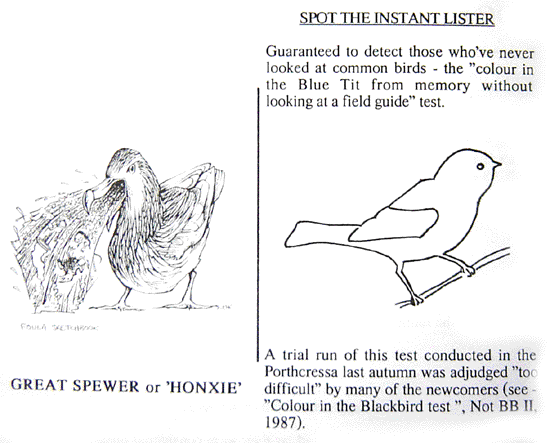
Bird-Spotting Typos
– It took me 35 years to see a really blue/orante one [Robin], but I have no doubt that it had crossed all of Europe – and why not? Hundreds of sympathetic Yellow-browed warblers do so every year.
– Norfolk birder Richard Millington finds his first swallow of summer is a Red-rumped, after ticking Bearded Tit at Hickling Broad.
June 1987 p.3
– Other Nearctic stars included a Black and White Warbler at Prawle (8-13th), a Purple Warbler at Nanquidno (13-23rd)…
This Year’s Competition
The ‘R. Stoff Commemorative Medallion’ and a year’s free subscription to Not BB are the prizes for this year’s competition. Simply send us a spoof letter which has been published in Bird-Spotting Magazine, and the funniest we receive in the next 12 months will win.
No correspondence will be entered into. Members of the Dusk family may not enter. (Editorials don’t count, Chris!)
Not British Birdshop
Albert Tito Owl Joke Book. It’s a hoot!
Blather and Furtive The Ageing of Dead Seabirds. A scratch’n’sniff guide to the Pterodromaroma, or “Blow-fly” petrels most likely to wash up in Yorkshire. Pen and ink illustrations.
D.I..Y. Wireloose The Brds of Wallacea. Recounts the remarkable bird-life to be found in this area that is part Western Palearctic, part Nearctic and part Oriental, but to most people looks like ordinary fields and chalk cliffs.
Duff, Hatton and Stirrup Not BB III Don’t be put off by the statistical tables.
Nao Ber-ding Common Birds of China. A charming monograph on the Tree Sparrow.
Peter Challison Seabirds – unrevised edition. You’ll believe a flightless grebe can fly!
Peter Hairyson Photographic Seabird Guide. Presents tangible evidence of rare seabirds.
Sofa Never Been Birding! Recounts his early life in broadcasting with some incredible mistakes on air.
Writers-Cramp et al. Birds of the Nearctic Vol V. Tyrant Flycatchers to Mockingbirds.
Special Engraving Offer to Not BB Subscribers
It is a sad fact that each year many birdwatchers lose or have valuable binoculars and telescopes stolen through failing to attach identification to them. Don’t let this happen to you.
Send your blank cheque and optics to us NOW! We shall arrange for your postcode to be clearly engraved on the objective lenses – a major deterrent to potential thieves.
Dudespeak
Genuinely heard in July at the Anglesey Bridled Tern – “Ooh yes, it is nice, isn’t it, with that lovely shaggy crest – much nicer than the dark one behind it.”
News and Gossip
A load of humbug In ssociation with the unprecedented invasion of Grey-cheeked Thrushes into southwest Britain in the autumn of 1986, we hear of a similar influx on a broader front of Black and White Warblers. Many of our readers are claiming sightings of particularly dowdy specimens and, it seems, several one-legged individuals have been forced to seek shelter in unusual places.
[Year 2005 editor’s note – anyone has the foggiest idea what this means?!]
Missing persons Have you recently seen or heard any of the following characters?
– Mr S. MacCormick
– an Oriental Prat who’s gone a bit cuckoo
– Dorian St Arling
– Dr Vernon Thrush
They all made brief appearances in the 1980s before mysteriously vanishing. Their cases have remained in our closed file under the bed ever since. Some are believed to be in hiding in post offices in the United States.
If you come across any of them, please approach with care, ring us at our headquarters and ask for Dick.
Weather news Defending the London Weather Centre’s inability to predict last October’s hurricane, Ian McCrestfallen claimed a technical fault had caused a computer crash. When questioned more closely, he revealed that a Sabine’s Gull had stolen the pine cones and a phalarope had eaten the seaweed.
Birder’s Lanyard Ever wondered who’s got the biggest list in the crowd of birders jostling for places on the Buccaneer” at the quayside on St Mary’s? Ever felt like sneering at the spotty kid nect to you with his Boots binoculars but afraid to do so in case he’s the legendary “Boy Roy”, or looked down your nose at the cosy couple in front of you only to later learn they were Mr and Mrs Rons who’ve seen more rarities than you’ve dipped Black Kites?
Well, here’s the solution – Not BB Enterprises presents the Birder’s Lanyard. Just send us an sae together with your British List and £5, and we’ll send you a binocular strap coloured according to the following convention:
